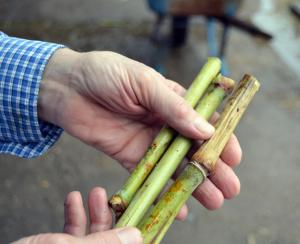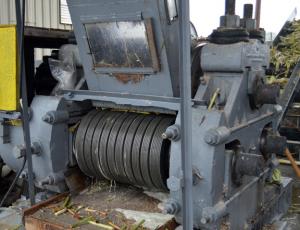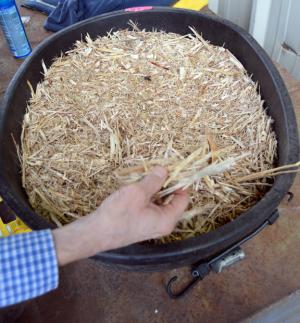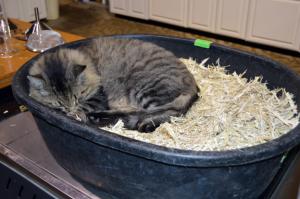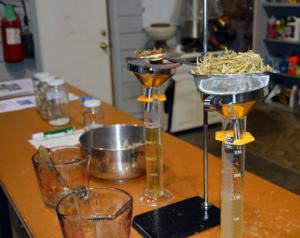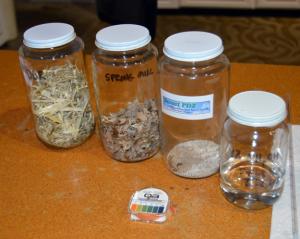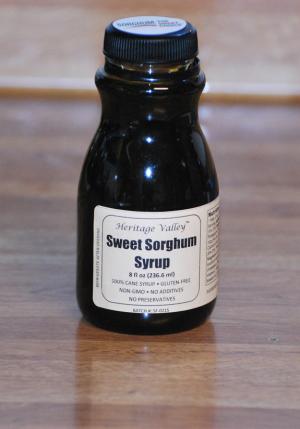By Nancy Brannon, Ph.D.
A Memphis-based company - Delta BioRenewables (DBR) - has developed a new horse bedding product made from plant fiber. The horse bedding is made from the dried fibers of sweet sorghum, and has twice the water absorbency of wood shavings and the ability to absorb and neutralize ammonia.
The company was started in 2009 as an outgrowth of a study by Memphis BioWorks looking for new crop opportunities for the Delta region. They were mainly looking for crops, perennials, to produce ethanol, but farmers weren’t much interested in perennials. So they looked at bringing back some older annuals. DBR now has 80 acres in sweet sorghum production at the Agricenter International, Memphis, TN.
Randy Powell, Ph.D., Technical Manager of DBR, said that sweet sorghum is an old crop. It came from Africa to the U.S. in the 1850s. Between 1850 and 1880, the plant was used for making syrup. By 1890 it was being grown in 44 states. Over 25 million gallons of sorghum syrup were produced across the U.S. and it was the predominant table sweetener before refined sugar. Around 1900-1910, the U.S. had three sweeteners – honey, maple syrup, and sorghum syrup. But within ten years, sorghum syrup was replaced by white sugar.
Sugar sorghum is a temperate climate crop. It is genetically adapted to a dry climate and can tolerate extended periods of drought. It’s an annual, so can fit in a crop rotation program. It has a C4 photosynthesis pathway, making it a plant most efficient in converting sunlight and CO2 into plant mass and nutrients. It is a very efficient producer and gives high crop yields.
The sugar juice in the stalk and fiber can be fermented to make ethanol, but that is not very economical. So DBR began searching for uses for the juice. A sweet sorghum syrup is easy to make. Simply boil off the water, filter out the seeds and pulp, and you have a product that is high in nutrients like iron, potassium, vitamin B6 and micronutrients. DBR has been making the syrup for about two years. It is best in baked goods and is a good substitute for brown sugar. It’s also good in marinades, glazes, and BBQ sauce, Powell said. But they mainly sell in bulk and their biggest customers are craft distilling and brewing companies, such as Ghost River Brewing. It also can be used to make premium whiskey.
So the next question is: what to do with the left over fibers after all the juice is processed out? And there is a LOT of fiber left over – called bagasse. DBR tried making solid fuel pellets and particle board, but it was not as good as wood. They can make animal feed, and cattle like it, Powell said. Then they came up with the idea of horse bedding, but the challenge was to get all the sugar out of it and get it dry enough.
DBR runs the sorghum through a “two mill” process, in which the juice is squeezed out, the pulp is crushed, water is added, and then it’s run through the two mills again to get more juice out. So, it gets milled four times, but this still doesn’t get all the sugar out.
Ensiling is an old process used to make silage. It’s a natural fermentation process in which lactic acid bacteria convert water soluble carbohydrates into organic acids, mainly lactic acid. So they store the bagasse in an anaerobic condition for 30 days for the ensiling process to be completed. The pH of the material drops as the lactic acid forms and it is stable for an extended period of time after ensiling. The final step is to run it through a drying process.
Powell ran a couple of experiments testing the water absorbency of the product to wood shavings, and testing the ammonia neutralization of his product to wood shavings and PDZ. In both experiments, the product outperformed wood shavings on water absorbency and outperformed both wood shavings and PDZ on ammonia neutralization.
BDR ran an evaluation at Murray State University in 2012-13 and has conducted trials at three other stables since then, the most recent at Spring Mill Farm in Eads earlier this year, with positive results.
As a result of their work, the USDA has awarded DBR a grant to scale-up production and introduce this bedding product to the marketplace. For more information about Delta BioRenewables, visit their website: http://www.deltabiorenewables.com/
A Memphis-based company - Delta BioRenewables (DBR) - has developed a new horse bedding product made from plant fiber. The horse bedding is made from the dried fibers of sweet sorghum, and has twice the water absorbency of wood shavings and the ability to absorb and neutralize ammonia.
The company was started in 2009 as an outgrowth of a study by Memphis BioWorks looking for new crop opportunities for the Delta region. They were mainly looking for crops, perennials, to produce ethanol, but farmers weren’t much interested in perennials. So they looked at bringing back some older annuals. DBR now has 80 acres in sweet sorghum production at the Agricenter International, Memphis, TN.
Randy Powell, Ph.D., Technical Manager of DBR, said that sweet sorghum is an old crop. It came from Africa to the U.S. in the 1850s. Between 1850 and 1880, the plant was used for making syrup. By 1890 it was being grown in 44 states. Over 25 million gallons of sorghum syrup were produced across the U.S. and it was the predominant table sweetener before refined sugar. Around 1900-1910, the U.S. had three sweeteners – honey, maple syrup, and sorghum syrup. But within ten years, sorghum syrup was replaced by white sugar.
Sugar sorghum is a temperate climate crop. It is genetically adapted to a dry climate and can tolerate extended periods of drought. It’s an annual, so can fit in a crop rotation program. It has a C4 photosynthesis pathway, making it a plant most efficient in converting sunlight and CO2 into plant mass and nutrients. It is a very efficient producer and gives high crop yields.
The sugar juice in the stalk and fiber can be fermented to make ethanol, but that is not very economical. So DBR began searching for uses for the juice. A sweet sorghum syrup is easy to make. Simply boil off the water, filter out the seeds and pulp, and you have a product that is high in nutrients like iron, potassium, vitamin B6 and micronutrients. DBR has been making the syrup for about two years. It is best in baked goods and is a good substitute for brown sugar. It’s also good in marinades, glazes, and BBQ sauce, Powell said. But they mainly sell in bulk and their biggest customers are craft distilling and brewing companies, such as Ghost River Brewing. It also can be used to make premium whiskey.
So the next question is: what to do with the left over fibers after all the juice is processed out? And there is a LOT of fiber left over – called bagasse. DBR tried making solid fuel pellets and particle board, but it was not as good as wood. They can make animal feed, and cattle like it, Powell said. Then they came up with the idea of horse bedding, but the challenge was to get all the sugar out of it and get it dry enough.
DBR runs the sorghum through a “two mill” process, in which the juice is squeezed out, the pulp is crushed, water is added, and then it’s run through the two mills again to get more juice out. So, it gets milled four times, but this still doesn’t get all the sugar out.
Ensiling is an old process used to make silage. It’s a natural fermentation process in which lactic acid bacteria convert water soluble carbohydrates into organic acids, mainly lactic acid. So they store the bagasse in an anaerobic condition for 30 days for the ensiling process to be completed. The pH of the material drops as the lactic acid forms and it is stable for an extended period of time after ensiling. The final step is to run it through a drying process.
Powell ran a couple of experiments testing the water absorbency of the product to wood shavings, and testing the ammonia neutralization of his product to wood shavings and PDZ. In both experiments, the product outperformed wood shavings on water absorbency and outperformed both wood shavings and PDZ on ammonia neutralization.
BDR ran an evaluation at Murray State University in 2012-13 and has conducted trials at three other stables since then, the most recent at Spring Mill Farm in Eads earlier this year, with positive results.
As a result of their work, the USDA has awarded DBR a grant to scale-up production and introduce this bedding product to the marketplace. For more information about Delta BioRenewables, visit their website: http://www.deltabiorenewables.com/
